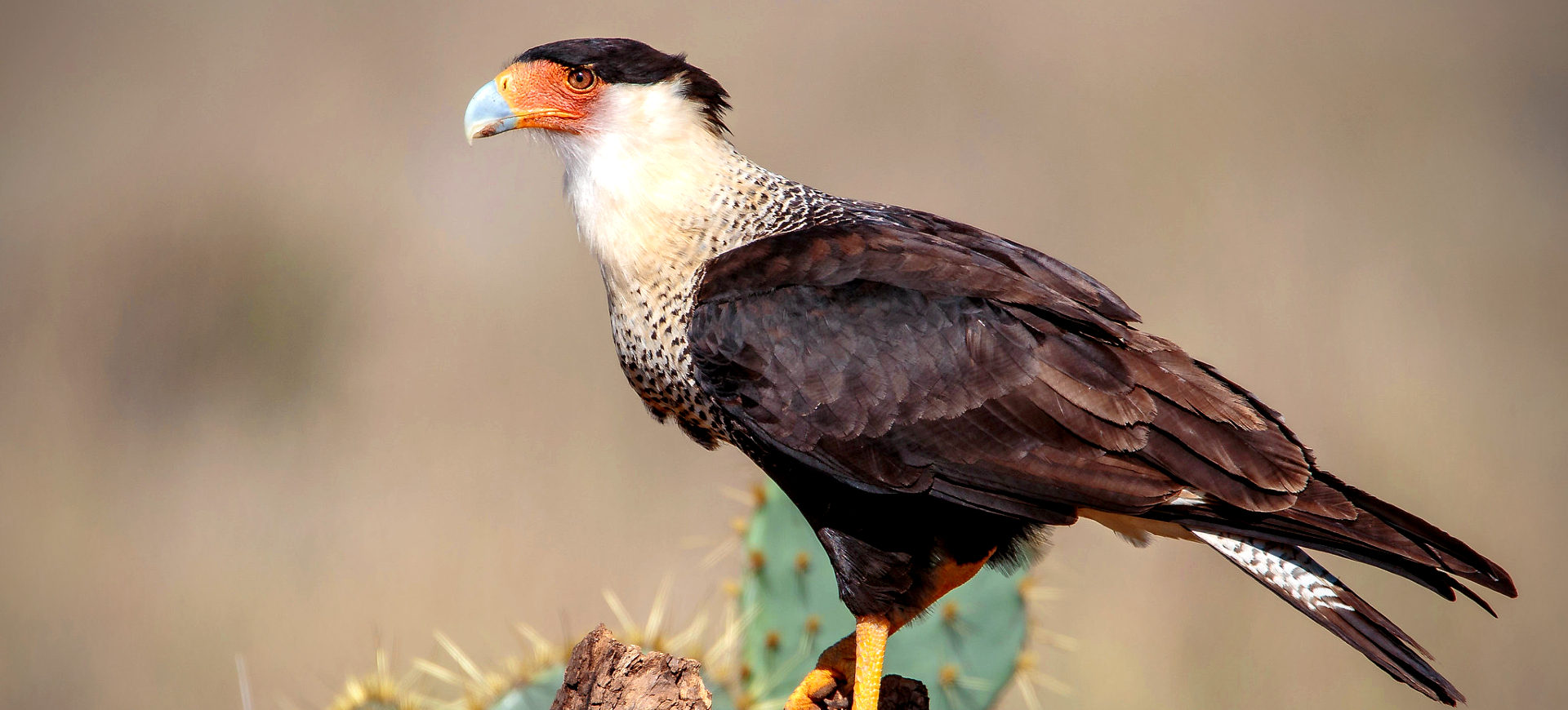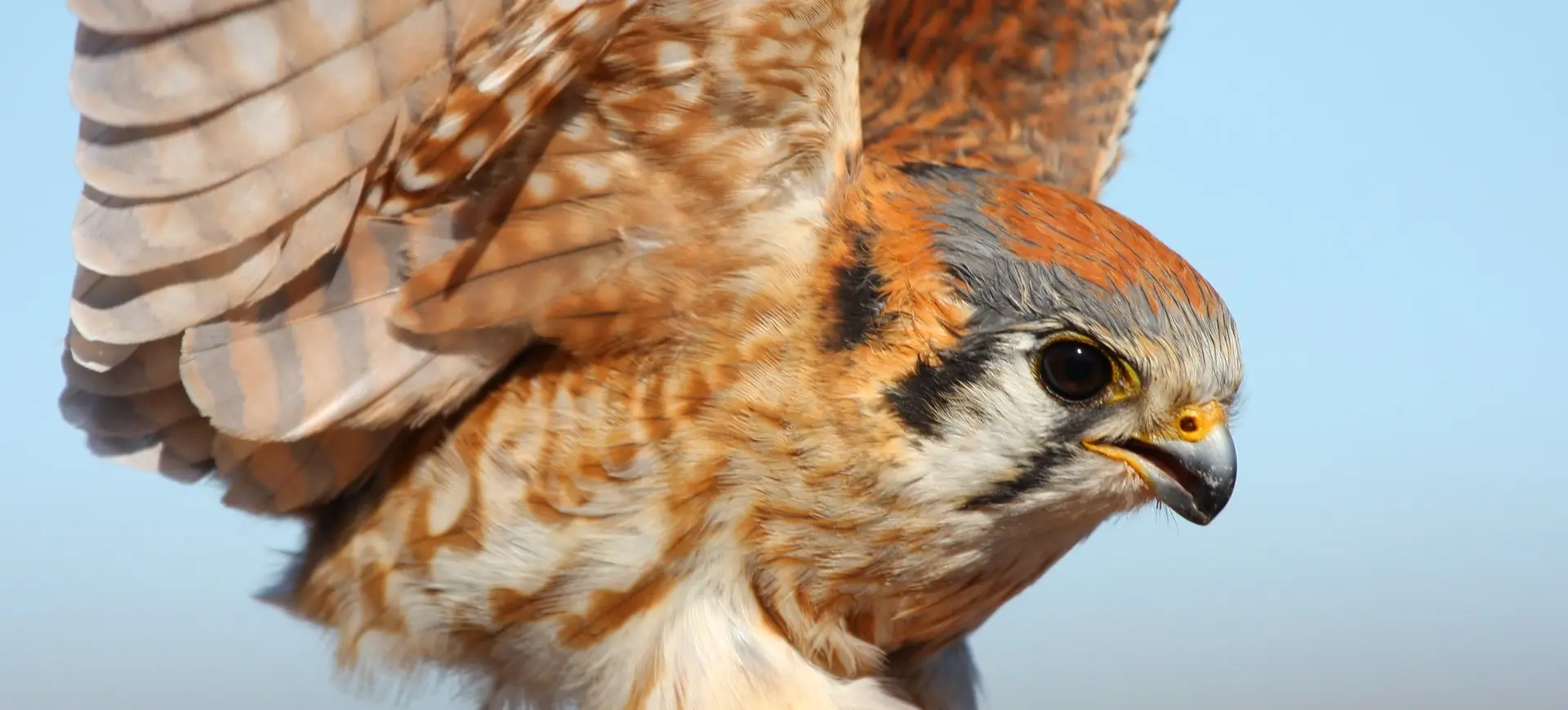Overview
The Pygmy Falcon, or African Pygmy Falcon (Polihierax semitorquatus), is the smallest raptor on the African continent, known for its distinctive, diminutive size. With a pale-colored body contrasted by its strikingly dark flight feathers, the Pygmy Falcon exhibits sexual dimorphism, with males typically bearing a rust-red color on the back and females showcasing a solid white eye stripe. These small raptors inhabit the arid savannahs of eastern and southern Africa, dwelling inside the large communal nests of Sociable Weavers or in the cavities of white-browed sparrow-weaver nests.
The Pygmy Falcon’s primary diet consists of insects, small reptiles, and birds, although they have been observed feeding small mammals. They are typically seen in pairs or small family groups and exhibit a unique form of polyandry, with some females maintaining two mates. Though they are tiny, they are fierce and can be quite territorial, especially when it comes to their chosen nesting site.
Despite being Africa’s smallest bird of prey, the Pygmy Falcon’s adaptive nature and wide distribution contribute to a stable population trend. However, they face threats related to habitat destruction, mainly due to increased human activity. Conservation efforts focus on habitat preservation and research to improve understanding of this intriguing raptor.
Taxonomy
Kingdom
Phylum
Class
Order
Family
Genus
Species
Type
Physical Description:
The Pygmy Falcon is an impressively small bird of prey, with adults reaching a maximum length of just 19-20 centimeters. Despite its small size, it’s a well-proportioned bird with a robust body, long wings, and a short tail, which allows it to maneuver with agility. Its eyes are dark and piercing, surrounded by a pale facial disk, while its beak is notably hooked, a typical trait of raptors, aiding in tearing apart prey.
Both sexes are primarily white underneath and on the face but exhibit sexual dimorphism in their upper body coloration. Males have a gray head and back, with a red ‘rump’ or lower back, while females replace the male’s gray with a clear white, accentuated by a distinctive black eye stripe. Their wings and tail are dark gray, with the flight feathers nearly black. The juvenile Pygmy Falcons are similarly colored to adults but are generally paler and fluffier.

Lifespan: Wild: ~7 Years || Captivity: ~10 Years

Weight: Male: 2.1-2.8 oz (60-80g) || Female: 2.3-3.2 oz (65-90g)

Length: Male & Female: 7.5-7.9 inches (19-20 cm)

Wingspan: Male & Female: 13.8 inches (35 cm)

Top Speed: 30 mph (48 km/h)
Characteristic:
Native Habitat:
The Pygmy Falcon inhabits arid and semi-arid regions of eastern and southern Africa, preferring open habitats with sparse ground cover and scattered trees or shrubs. They are particularly fond of acacia savannahs and thorny scrublands, where abundant food and nesting sites are readily available.
The falcons are also found near dry riverbeds, grasslands, and open woodlands. They have a particular penchant for regions where Sociable Weavers and White-browed Sparrow-Weavers are present, as they rely on their large communal nests for shelter and nesting sites. The nests offer the falcons protection from predators and harsh weather conditions, and their proximity to water sources makes them ideal hunting grounds.
Climate Zones:
Biomes:
Biogeographical Realms:
Continents:
Diet:
Diet & Feeding Habits:
Pygmy Falcons are primarily insectivorous, preying upon arthropods such as spiders, scorpions, and insects. This diet is supplemented with small vertebrates, including lizards, birds, rodents, and occasionally small mammals. Their small size and agility allow them to maneuver quickly, ambushing and swiftly grabbing their prey with their sharp talons.
The falcons often hunt from a low perch, scanning the surroundings for potential prey. Once the prey is spotted, they swoop to catch it in the air or on the ground. They are also known to catch insects in flight. Despite their small size, Pygmy Falcons are fierce hunters, sometimes taking on prey larger than themselves. Their hunting activities are typically more pronounced in the early morning and late afternoon.
Mating Description:
Pygmy Falcons engage in monogamous or polyandrous mating systems, with some females maintaining two male mates simultaneously. During the breeding season, which varies depending on the region but generally occurs during the local dry season, males perform aerial displays to attract females, involving high-speed chases and dive-bombing.
Once a pair is formed, they select a compartment in a Sociable Weaver’s nest or a cavity in a White-browed Sparrow-Weaver’s nest as their nesting site. The female lays 2-4 eggs, which both parents incubate for about a month. After hatching, the chicks are cared for by both parents, with some assistance from secondary males in polyandrous arrangements. The young falcons fledge after 30-35 days but remain dependent on their parents for a few more weeks.
Reproduction Season:
Birth Type:
Pregnancy Duration:
Female Name:
Male Name:
Baby Name:
Social Structure Description:
Pygmy Falcons are generally solitary or live in monogamous pairs, although some females may have two male mates. They are territorial, defending their selected nesting site against intruders. Pygmy Falcons, despite their small size, can be aggressive, especially when protecting their territory or young.
These birds live near Sociable Weavers or White-browed Sparrow-Weavers, whose nests they inhabit. This relationship is unique in that it’s neither purely parasitic nor mutualistic – while the falcons benefit from the shelter provided by the weavers’ nests, they also help deter predators threatening the weavers.
Groups:
Conservation Status:
Population Trend:
The exact numbers of the Pygmy Falcon population in the wild are not known, but the species is generally considered typical within its range. It’s most abundant in the dry savannahs and scrublands of eastern and southern Africa, mainly where Sociable Weavers and White-browed Sparrow-Weavers are present.
Although population densities vary based on food availability and nesting sites, Pygmy Falcons are typically solitary or found in pairs or small family groups. Some areas have reported densities as high as one pair per square kilometer. Given the broad geographical range of this species, the overall population is likely to be substantial.
Population Threats:
Pygmy Falcons face threats mainly associated with habitat loss and degradation, primarily due to increased human activities such as agriculture and urbanization. As they depend on Sociable Weaver and White-browed Sparrow-Weaver nests for nesting sites, any decline in these species due to habitat change could impact the Pygmy Falcon.
Furthermore, pesticide use can reduce prey availability while posing a direct threat if the falcons consume poisoned prey. Climate change, potentially altering the distribution and abundance of prey species, could also pose a long-term threat to this species.
Conservation Efforts:
The Pygmy Falcon currently has a conservation status of ‘Least Concern’ due to its wide distribution and seemingly stable population. The primary conservation efforts for this species are focused on habitat preservation and mitigating the impact of human activities.
A significant aspect of conservation efforts includes research to better understand the species, its habits, and its relationship with the environment. This knowledge can then be used to develop more effective conservation strategies. Additionally, measures to regulate pesticide use and promote sustainable farming practices can indirectly benefit the Pygmy Falcon by protecting its food sources.
Additional Resources:
Fun Facts
- The Pygmy Falcon is the smallest raptor in Africa.
- They often live inside the nests of Sociable Weavers, a much larger bird species.
- Female Pygmy Falcons can have two mates simultaneously, a behavior known as polyandry.
- Despite their small size, they are fierce hunters and can take on prey larger than themselves.
- Pygmy Falcons are not migratory and tend to stay within a few kilometers of their nesting site.
- The species’ scientific name, “Polihierax semitorquatus,” translates to “half-collared small hawk.”
- Juvenile Pygmy Falcons practice their hunting skills by playfully attacking twigs and leaves.
- Pygmy Falcons are primarily insectivorous, but will also eat small reptiles and even other birds.
- Males and females look different – males have a grey head and back, while females have a black eye-stripe.
- The lifespan of a Pygmy Falcon can be up to 5-7 years in the wild and up to 10 years in captivity.









